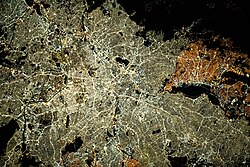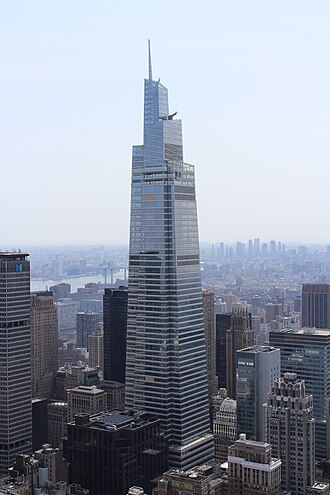São Lenoas
São Lenoas | |
|---|---|
City | |
 View from Torre Alvares | |
| Nickname: Prosperity State | |
| Motto: In ancestral footsteps we tread. | |
 | |
| Country | Carinansia |
| State | São Lenoas |
| Province | São Pacária |
| Incorporated | 14 March 1524 |
| Founded by | Coquus Ursus |
| Seat | Casa Serena |
| Boroughs |
|
| Government | |
| • Type | Mayor–council government |
| • Body | Municipal Council |
| • Mayor | Márcia Salles Villa (Party of the Carinansian Revolution) |
| • Chairman of the City Council | Roberto Sanches Vidal |
| Population (2100) | |
| • Total | 31,623,714 |
| Demonym | lenistana |
| Time zone | GMT+11:00 |
The city of São Lenoas is the largest in Carinansia, Oikoia, the Eastern Hemisphere, and the second largest in the world. As the continent's premier financial center, it is responsible for substantial amounts of regional trade. Originating as a slave hub founded by the Moliropa Company in the 1520s, it became one of the country's 10 largest cities by 1830 following years of sustained growth following initial rapid development. From 1830 to 1965, it was the third largest city, and quickly grew as it received internal migrants from San Luis and Mangulak, as well as international migrants fleeing external conflicts and seeking economic opportunity. Since 2030, it has been the largest city in Oikoia, and is home to the São Lenoas Stock Exchange, the country's premier stock exchange worth approximately $2.1T in 2100.
Geography
São Lenoas is the largest city of the most populous state in Carinansia, São Lenoas (state), located at latitude 23°33'01'' south and longitude 46°38'02'' east. The total area of the municipality is 35,467.2 square kilometres, according to the Carinansian Institute of Geography and Statistics (ICGE), being the second largest in the state in terms of territorial extension. The entire municipality is considered to be urban.
The city is on a plateau placed beyond the Serra do Plano (Carinansian for "Plains Range"), itself a component of the vast region known as the Altiplano, with an average elevation of around 711 meters above sea level, although being at a distance of only about 65 kilometers from the Comarillos Strait. The distance is covered by three highways, the Jucambe, Pacaria, and Libertad, (see "Transportation" below) that roll down the range, leading to the Comarillos Tunnel and the beach resort of Buenas Velas, ultimately arriving to the ports of Pecadores and Punto Banderas. Rolling terrain prevails within the urbanized areas of São Lenoas except in its northern area, where the Sierra Patria Range reaches a higher elevation and a sizable remnant of the Eneas rainforest. The region is seismically stable and no significant activity has been recorded since the 1768 earthquake. The Interstate Maglev also crosses the city, connecting mainland Oikoia to Lekeadia via the Comarillos and Buenavista Tunnels in the northern and southern edges of the city.
Government
Economy
São Lenoas is considered the financial capital of Carinansia, as it is the location for the headquarters of major corporations, banks, financial institutions, and civil society. São Lenoas is Carinansia's highest GDP city and one of the largest in the world, wealthier than the 10th richest country by GDP globally. According to data from the ICGE, its gross metropolitan product (GMP) in 2096 was CAR$2.1T, approximately ISC$2.2T, 10.9% of Carinansia GDP and 70.5% of the state's GRP. According to Gennegneux Co. average annual economic growth of the city is 6.9%. São Lenoas also has a moderate "informal" economy, primarily consisting of legal goods sold untaxed. In 2096, the city of São Lenoas collected CAR$150 billion in taxes and the city budget was R$100 billion. The city has 4,750 bank branches and 190 shopping malls.
As of 2095, São Lenoas is the fourth largest exporting municipality in Carinansia after Pecadores, SL, Napo, EK, and Punto Banderas, SL. In that year São Paulo's exported goods totaled $29.32B (ISC) or 3.23% of Carinansia's total exports. The top five goods exported by São Lenoas are silver (20%), raw sugar (17%), computer chips (8.5%), nickel (7.6%), and oranges (3.4%). The São Lenoas Stock Exchange (SL&PB MF) is the official stock and bond exchange of the state of São Lenoas, as well as the country's largest. It is also the largest stock exchange in Oikoia, trading about CAR$51 billion (ISC53.4 billion) every day.
São Lenoas' economy underwent a substantial transformation during the early 21st century. Formerly a city with a strong industrial character, São Lenoas' economy followed the global trend of shifting to the tertiary sector of the economy, focusing on services. Despite this, some industrial operations still take place in the state. 54% of all the international companies with business in Carinansia have their head offices in São Lenoas. São Lenoas has one of the largest concentrations of Emmerian businesses worldwide and is the largest Cydoni industrial hub alongside Klajong. São Lenoas ranked first in DGJ magazine's bi-annual ranking of Cities of the Future 2096-2097 in Oikoia, overtaking New Lucent, the first city in the previous ranking. It now ranks third, followed by Delhinmar. The per capita income for the city was CAR$68,927 in 2097. According to current city rankings of cost of living for expatriate employees, São Lenoas is now considered the 7th most expensive city in the world.
The Novo Mundo Roberto Sanchez, in Roberto Sanchez Avenue, is Carinansia's second oldest mall, opened in 1923. The Flores neighborhood is regarded among the most sophisticated places in town, with upscale restaurants and hotels, some considered among the best in the world. Across Flores there are luxury car dealers. Two of the world's best restaurants as elected by The World's 15 Best Restaurants Award, Espidores Centro, and Nakada's is there.
Tourism
Demographics
| Historical population | ||
|---|---|---|
| Year | Pop. | ±% |
| 1967 | 2,005,679 | — |
| 1987 | 3,128,404 | +56.0% |
| 2007 | 5,678,941 | +81.5% |
| 2027 | 7,720,813 | +36.0% |
| 2047 | 11,492,052 | +48.8% |
| 2076 | 19,310,583 | +68.0% |
| 2096 | 28,367,230 | +46.9% |
São Lenoas population growth has been rapid since the end of the civil war. Originally the third-largest city in the Serenacy when the state was first admitted in 1965, By the third census in 1987, it was the largest city in the country, slightly larger than Vóclaria City. Since 2076, the city's first-generation immigrant population has grown from 28.9% of the population to 51.1%. Such massive population growth has seen it urbanise the entire province of São Pácaria, and consolidate the province and municipal governments. Of the first-generation immigrants, 34.1% come from other states in the country. The rest come from all over the world, including Wexford, Tengxing, and even Rostok.
In 2099, São Lenoas is the largest city in Oikoia and the fourth largest city in the world.
City Landscape
Torre Lenistana
| Torre Lenistana | |
|---|---|
 | |
| Former names | Bank of San Juan Trust |
| General information | |
| Type | Skyscraper |
| Groundbreaking | 13 April 2028 |
| Construction started | 29 July 2036 |
| Construction stopped | 2 February 2038 |
| Completed | 13 May 2038 |
| Inaugurated | 16 June 2038 |
| Cost | $3.02 billion |
| Owner | Trijar Co. |
| Height | 464m |
| Technical details | |
| Floor count | 70 |
| Floor area | 162,600.0 sq m |
| Design and construction | |
| Architect | José Watanabe Nogueira |
Construction on the skyscraper began shortly after the conclusion of the Vascara War. In order to provide employment to some returning veterans, the state provided subsidies for local infrastructure projects. The Bank of San Juan Trust agreed to finance a new tallest building, and after months of planning, ground broke in 2028. However, infighting among architects quickly resulted in several design changes, causing delays and pushing back the date of construction by years. Only in 2036 was a final design approved, and construction began. Less than two years later, the building was completed, inaugurated on National Liberation Day (Carinansia).
Currently, the tower is subdivided into several sections. Floors 1 to 8 are dedicated to retail and restaurants, drawing millions of visitors annually. Floors 9 to 11 are service floors, and 12 to 45 are occupied by various offices. Suroikoian Airways specifically is headquartered on floors 20 to 32, and WPB S.A. on 33 to 45. Floors 46 to 51 are service floors, and floors 52 to 59 are luxury apartments. Floors 60 to 67 is the Lenistano Hotel, the 68th and 69th floors are home to the exclusive Mirandas Restaurant. The top floor holds an observatory, from which there is an extensive view of the Zalguda Park.
Originally, the Bank of San Juan Trust occupied the top 25 floors, choosing to sublet the floors below to various offices. When the bank became insolvent in 2062, it was purchased by Roberto Bitencourt. He chose to let the entire building to various investors, before establishing high-end retail and musical performances from the 1st to 14th floor. He sold the building to Trijar, Co. in 2076 for $11.2 billion.